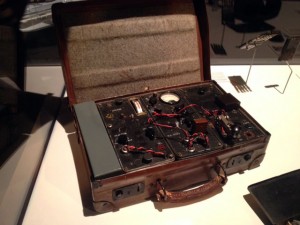
There is no James Bond in the exhibit Spy: The Secret World of Espionage that is open now at the Pacific Science Center. That’s ok though because it doesn’t need any of James Bond’s kiss kiss bang bang cinematic flair. This exhibit has everything that is cool, dangerous, mysterious, and exciting about the real world of real spies.
The exhibit begins with an immersive experience where you are introduced to the value of espionage through the words of US presidents – starting with George Washington. From there you enter into a series of galleries that begin with the Office of Special Services (OSS) in World War II and moves through the Soviet era, Berlin, profiles of real spies, and real-world spy scenarios. Along the way there are interactive experiences related to a variety of espionage activities. You learn about secret codes where you can peer into a microscope to read the text of a microdot no larger than the period at the end of this sentence. Create a disguise for yourself by taking a photo and then adding hats, wigs, glasses, moustaches, and other concealing items. Step into a booth, record your voice, and then distort it so you sound like someone else. Of all the interactive experiences what is sure to be a highlight of the exhibit for many younger visitors is an actual laser security field. Unlike James Bond these lasers aren’t intended to cut you in half but rather present a maze of super-sensitive detectors. Your mission: cross the room without setting them off. It’s fiendishly difficult, looks incredibly cool, and is tremendous fun. If Dad goes missing during your visit I think you’ll know where to find him. Parents should know, however, that aside from some of these interactive experiences there might not be a lot here for younger kids. Considering the deep sociopolitical context of much of the information and the way it is presented I think this exhibit is best for kids ages 10 and up. Younger kids may be fascinated by a camera strapped to a pigeon or the cockpit of an A-12 Oxcart supersonic spy plane but may find the presentation of much of the information a bit boring.

But for those who can understand the implications the exhibit is packed with a dizzying array of historic artifacts from an actual German Enigma machine to the ice climbing axe that killed Leon Trotsky, a piece of Gary Powers’ downed U2 spy plane, a Bulgarian Assassination Umbrella, a hollowed out tooth, KGB surveillance photos, and a robotic dragonfly created by the CIA; the list goes on and on. All of these items are used to illustrate and educate about some aspect of espionage, concealment, observation, information gathering and exchange, suppression, security, communication and so on. Among all the interesting gadgets and tools of what spies refer to as “tradecraft” there are also a great many human stories of patriotism, sacrifice, and greed that bring a compelling human element to The Secret World of Espionage. You may feel sympathy for a Soviet spy executed for doing what he thought was the right thing, or contempt for an American spy who betrayed his country out of greed. As you go deeper into the exhibit and learn about programs like Operation Ghost Stories you may wonder, is the person standing next to you a spy?
With the NSA, Edward Snowden, and WikiLeaks in the news so much these days it’s valuable to look back at the history of espionage to gain a better understanding of issues surrounding information, privacy, and national security. The exhibit Spy: The Secret World of Espionage may not provide all the answers but it will certainly raise a lot of questions.
A few fun facts. Did you know…
Boris Pasternak won the Nobel Prize in Literature because the CIA printed miniature copies of his novel Doctor Zhivago in Russian and smuggled them into the Soviet Union? Not because they wanted him to win the prize but because the popular book was critical of the Soviet system.
The A-12 Oxcart spy plane flew at the edge of space and at more than 3 times the speed of sound? It flew so fast that friction with the atmosphere could heat the air around the plane to 400 degrees Fahrenheit.
The German Enigma code machine could create 150,000,000,000,000,000,000 possible combinations to any one enciphered message? The Allies were still able to break the code and in doing so created the world’s first electronic computer, Colossus.
The CIA created a robotic catfish named “Charlie” to explore the use of unmanned underwater vehicles (UUVs) for aquatic missions? “Charlie” has a pressure hull and ballast system in its body and a propulsion system in its tail so that it looks remarkably realistic when it is swimming.
If you go…
Spy is a timed-entry exhibit similar to the recent King Tut or Harry Potter exhibits so you’ll want to plan your trip and purchase tickets in advance. More information can be found at http://www.pacificsciencecenter.org/Exhibits/spy.